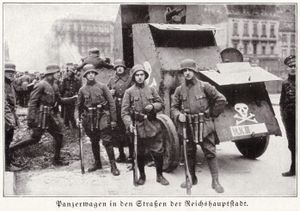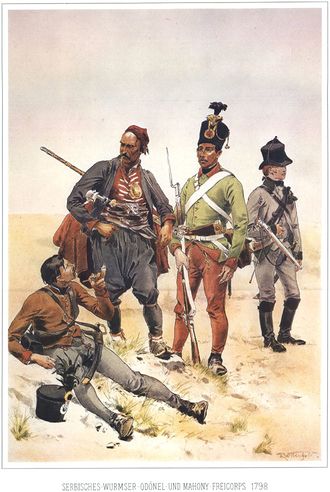فرايكورپس

Freikorps (ألمانية: [ˈfʁaɪˌkoːɐ̯], "Free Corps") were irregular German military volunteer units that existed from the 18th to the early 20th centuries, which effectively fought as mercenary or private armies, regardless of their own nationality. In German-speaking countries, the first so-called Freikorps ("free regiments", Freie Regimenter) were formed in the 18th century from native volunteers, enemy renegades and deserters. These sometimes exotically equipped units served as infantry and cavalry (or more rarely as artillery), sometimes in just company strength, sometimes in formations up to several thousand strong; there were also various mixed formations or legions. The Prussian von Kleist Freikorps included infantry, jäger, dragoons and hussars. The French Volontaires de Saxe combined uhlans and dragoons.
In the aftermath of World War I and during the German Revolution of 1918–19, Freikorps consisting largely of World War I veterans were raised as right-wing paramilitary militias, ostensibly to fight on behalf of the government[1] against the Soviet-backed German Communists attempting to overthrow the Weimar Republic.[2][3] However, the Freikorps also largely despised the Republic and were involved in assassinations of its supporters.[4][5]
Origins
The very first Freikorps were recruited by Frederick the Great during the Seven Years' War. On 15 July 1759, Frederick ordered the creation of a squadron of volunteer hussars to be attached to the 1st Regiment of Hussars (von Kleist's Own). He entrusted the creation and command of this new unit to Colonel Friedrich Wilhelm von Kleist. This first squadron (80 men) was raised in Dresden and consisted mainly of Hungarian deserters. This squadron was placed under the command of Lieutenant Johann Michael von Kovacs. At the end of 1759, the first four squadrons of dragoons (also called horse grenadiers) of the Freikorps were organised. They initially consisted of Prussian volunteers from Berlin, Magdeburg, Mecklenburg and Leipzig, but later recruited deserters. The Freikorps were regarded as unreliable by regular armies, so they mainly were used as sentries and for minor duties.[بحاجة لمصدر]
See also
- Freikorps Awards
- Landsknecht
- List of defunct Paramilitary Organizations
- List of Free Corps
- List of Freikorps members
- List of paramilitary organizations
- Organisation Consul
- Freikorps in the Baltic
- Battle of Annaberg
- Free Corps Denmark
- Viking League related Freikorps activities
- Free company Medieval units with some similarities
References
Notes
- ^ Haffner, Sebastian (2000). Defying Hitler. Picador. pp. 30–31, 33. ISBN 0-312-42113-3.
- ^ William L. Shirer, The Rise and Fall of the Third Reich: A History of Nazi Germany, New York, NY, Simon & Schuster, 2011, p. 55
- ^ Heiden, Konrad (1944). Der Fuehrer: Hitler's Rise to Power. Boston, MA: Houghton Mifflin Company. pp. 21-22.
- ^ Heiden, Konrad (1944). Der Fuehrer: Hitler's Rise to Power. Boston, MA: Houghton Mifflin Company. pp. 23-24.
- ^ Heiden, Konrad (1944). Der Fuehrer: Hitler's Rise to Power. Boston, MA: Houghton Mifflin Company. pp. 88-89.
Bibliography
- Blanke, Richard (1993). Orphans of Versailles: The Germans in Western Poland, 1918–1939. University Press of Kentucky. ISBN 0-8131-1803-4.
- Childers, Thomas (2017). The Third Reich: A History of Nazi Germany. New York: Simon & Schuster. ISBN 978-1-45165-113-3.
{{cite book}}: Invalid|ref=harv(help) - Davidson, Eugene (2004). The unmaking of Adolf Hitler. University of Missouri Press. ISBN 9780826215291.
{{cite book}}: Invalid|ref=harv(help) - Geiss, Immanuel; Jacobmeyer, Wolfgang, eds. (1980). Deutsche Politik in Polen 1939-1945. Aus dem Diensttagebuch von Hans Frank, Generalgouverneur in Polen (in German). Opladen: Leske + Budrich. ISBN 978-3810002969.
{{cite book}}: Invalid|ref=harv(help)CS1 maint: unrecognized language (link) - Eley, Geoff (1990). "Conservatives and radical nationalists in Germany: the production of fascist potentials, 1912–28". In Blinkhorn, Martin (ed.). Fascists and Conservatives: The Radical Right and the Establishment in Twentieth-Century Europe. New York, NY: Routledge. pp. 50–70. ISBN 978-0-049-40087-0.
{{cite book}}: Invalid|ref=harv(help) - Gerwarth, Robert (2008). "The Central European Counter-Revolution: Paramilitary Violence in Germany, Austria and Hungary after the Great War". Past & Present. 200 (1): 175–209. doi:10.1093/pastj/gtm046. S2CID 161539557.
{{cite journal}}: Invalid|ref=harv(help) - Hoess, Rudolf; Fitzgibbon, Constantine; Levi, Primo (2000). Commandant of Auschwitz: The Autobiography of Rudolf Hoess. Translated by Constantine Fitzgibbon, Joachim Neugroschel. Sterling Publishing. ISBN 1-84212-024-7.
- Hürter, Johannes (2007). Hitlers Heerführer. Die deutschen Oberbefehlshaber im Krieg gegen die Sowjetunion 1941/42. 2nd edition (in German). Oldenbourg, Munich. ISBN 978-3-486-58341-0.
{{cite book}}: Invalid|ref=harv(help)CS1 maint: unrecognized language (link) - Koepp, Roy G. (2010). Conservative Radicals: The Einwohnerwehr, Bund Bayern Und Reich, and the Limits of Paramilitary Politics in Bavaria, 1918–1928 (PhD). Lincoln, NE: University of Nebraska.
{{cite thesis}}: Invalid|ref=harv(help) - Kolko, Gabriel (1994). Century of War: Politics, Conflicts, and Society since 1914. New York, NY: The New Press. ISBN 978-1-565-84192-5.
{{cite book}}: Invalid|ref=harv(help) - Morris, Douglas G. (2005). Justice Imperiled: The Anti-Nazi Lawyer Max Hirschberg in Weimar Germany. University of Michigan Press. ISBN 0-472-11476-X.
- Mueller, Michael (2007). Canaris. Naval Institute Press. ISBN 9781591141013.
- Padfield, Peter (2001). Hess: The Fuhrer's Disciple. London: Cassell & Co. ISBN 0-304-35843-6.
{{cite book}}: Invalid|ref=harv(help) - Read, Anthony (2004). The Devil's Disciples: Hitler's Inner Circle. W. W. Norton & Company. ISBN 0-393-04800-4.
- Waite, Robert G. L. (1969) [1952]. Vanguard of Nazism: The Free Corps Movement in Post-War Germany, 1918–1923. New York, NY: W. W. Norton & Company. OCLC 3633548.
وصلات خارجية
 Media related to Freikorps at Wikimedia Commons
Media related to Freikorps at Wikimedia Commons
- Short description is different from Wikidata
- Use dmy dates from November 2014
- مقالات ذات عبارات بحاجة لمصادر
- Military units and formations established in 1759
- 1759 establishments in Prussia
- Military units and formations disestablished in 1939
- 1939 disestablishments in Germany
- Freikorps
- Anti-communism in Germany
- Military history of Germany
- Political repression in Germany
- Terrorism in Germany
- Counter-revolutionaries
- الثورة الألمانية 1918–1919
- Right-wing politics in Europe
